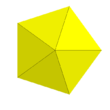| Snub 24-cell | ||

| ||
| Type | Uniform 4-polytope | |
| Schläfli symbol[1] | s{3,4,3} sr{3,3,4} s{31,1,1} | |
| Coxeter-Dynkin diagrams |
| |
| Cells | 144 | 96 3.3.3 (oblique) 24 3.3.3 24 3.3.3.3.3 |
| Faces | 480 {3} | |
| Edges | 432 | |
| Vertices | 96 | |
| Vertex figure |  (Tridiminished icosahedron) | |
| Symmetry groups | [3+,4,3], 1/2F4, order 576
[(3,3)+,4], 1/2B4, order 192 | |
| Dual | Dual snub 24-cell | |
| Properties | convex | |
| Uniform index | 30 31 32 | |

8 faces:


5 3.3.3 and 3 3.3.3.3.3
In geometry, the snub 24-cell or snub disicositetrachoron is a convex uniform 4-polytope composed of 120 regular tetrahedral and 24 icosahedral cells. Five tetrahedra and three icosahedra meet at each vertex. In total it has 480 triangular faces, 432 edges, and 96 vertices. One can build it from the 600-cell by diminishing a select subset of icosahedral pyramids and leaving only their icosahedral bases, thereby removing 480 tetrahedra and replacing them with 24 icosahedra.
Topologically, under its highest symmetry, [3+,4,3], as an alternation of a truncated 24-cell, it contains 24 pyritohedra (an icosahedron with Th symmetry), 24 regular tetrahedra, and 96 triangular pyramids.